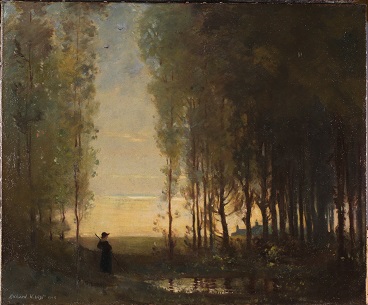A recent painting conservation treatment at McKay Lodge Conservation Laboratory uncovered a pleasant surprise: a hidden figure.
At first the painting appeared as a simple, but serene landscape; however, an exciting discovery was made as surface cleaning progressed which was not only unexpected, but gratifying.
Landscape by Richard W. West arrived at McKay Lodge Conservation Laboratory because the gold frame that accompanied the painting had sustained physical damage. Once the artwork arrived, Stefan Dedecek, Conservator of Paintings, Murals and Polychrome Surfaces noticed both the structure and appearance of the painting could be improved by conservation treatment.

The canvas was distorted causing undulations in surface of the painting. The aged varnish had considerably darkened, discoloring the sky and obscuring the details of the trees. Something else also caught the conservator Dedecek’s well-trained eye: a large portion of the painting appeared to have been “overpainted”.
The term overpainting in art conservation refers to painting over areas to cover damage or sometimes subject matter, which can change the appearance or context of the original artwork. Though a trained professional can often observe overpaint with standard lighting conditions, examination with Ultraviolet Induced Visible-Fluorescence (UV-vis) can readily reveal overpaint as dark colored areas, or areas that do not fluoresce.
UV-vis is non-invasive but powerful diagnostic technique allowing a conservator to observe damages, varnishes, coatings, or previous restoration that might otherwise be concealed under normal illumination. For more complete explanation on the use of UV for conservation documentation, click here.

When Landscape by Richard W. West was viewed under UV illumination several suspected overpainted areas are seen as dark areas (or areas that do not fluoresce). Two areas appear at the lower left as well as the foreground and in the foliage in the upper right quadrant.
Conservator Dedecek carefully reduced the dirt and discolored varnish. With the help of a binocular microscope, he progressively removed the previous overpaint while leaving the original paint below undisturbed. This part of the paintings conservation treatment requires great care on the part of the conservator.
As was previously mentioned, overpaint often covers previous damage, so then would there even be any original paint underneath the restoration layer? Or had it been so badly damaged that that was the reason it had been painted over in the first place? Only time and meticulous removal would reveal the true condition of the painting.
A hidden figure standing next to the pond then emerged during the cleaning process. The sky also changed from midday to sunset (or sunrise). The date the painting was likely created, 1914, was also revealed along with greater overall clarity of trees and foreground.

As for the man and the time of day, art dealers have been known to “adjust” an artwork’s appearance to fit current fashion or change other attributes for monetary gain. It is not certain why the date was covered since it is by the signature.
After the painting conservation treatment, not only did the overall appearance improve, it also revealed the original date and the subject matter intended by artist who painted this charming landscape, Richard W. West. West was an accomplished artist and had a long life. He was born in 1887 and lived until 1970. His portraits and landscapes show he had remarkable skill handling paint.
